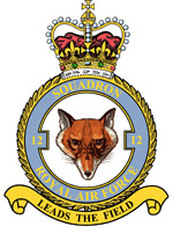
12 Squadron was formed on 14 February 1915 at Netheravon from a nucleus of crew and aircraft provided by No. 1 Squadron. In April 1916, the Squadron moved to St Omer, France equipped with BE2Cs primarily in the long-range reconnaissance role. By April 1918, No. 12 Squadron had added night bombing and strafing to its repertoire. After the Armistice, the Squadron moved to Germany as part of the Army of Occupation and by November 1919 was the sole operational squadron in Germany until July 1922 when it was disbanded. The Squadron reformed in April 1923 with DH9As spending a short time at Northolt before moving to Andover where it became engaged in the development of bombing techniques. It was during this time that the squadron received the designation 12(B) squadron, for Bomber, to denote its primary mission. In 1926, the Squadron became the sole operator of the Fairey Fox, an aircraft that outpaced many contemporary fighters and revolutionized bomber tactics.
In 1935, flying Hawker Harts, the Squadron moved to Aden in response to the Italian invasion of Abyssinia. They returned home in 1936 and re-equipped with Hinds. At the start of World War II, No. 12 (B) Squadron departed for France as part of the Advanced Air Striking Force equipped with Fairey Battles. In May 1940, Fg Off Garland and Sgt Gray, his observer, led a flight of aircraft in an attack on a vital bridge over the Albert Canal. All of the aircraft were shot down by fierce enemy ground fire, but one end of the bridge was destroyed and both Garland and Gray were posthumously awarded the Victoria Cross, the first of the war for the RAF. After the British withdrawal from France in June 1940, the Squadron began night attacks on enemy shipping and re-equipped with Wellingtons. Two years later, Lancasters were taken on strength and these lasted until August 1946, when Lincolns replaced them.
During 1952, No. 12 (B) Squadron received Canberra jet-bombers, and these were used in support of Operations Firedog (Malaya) and Musketeer (Suez). In July 1961, the Squadron was disbanded but reformed a year later at Coningsby with Vulcans, in which they won the 1964 US Strategic Air Command bombing competition and completed several around-the-world flights. The Squadron once again disbanded in late 1967 before reforming again in October 1969 with Buccaneers.
After a period of relative stability performing the maritime strike mission, No. 12 (B) Squadron moved to Lossiemouth from Honington in 1980. In January 1991, No. 12 (B) Squadron was hastily deployed to the Persian Gulf to support strike operations with the Pave-Spike pod, providing an airborne laser designator for the RAF's Paveway Laser Guided Bombs dropped from Tornado GR1s. In 1993 Tornado GR1Bs replaced the squadrons Buccaneers, though the squadron continued in the maritime strike role until 1998. During December 1998, the Squadron took part in Operation Desert Fox, the four-day air campaign against Iraq. Deployments to the Gulf continued, flying the upgraded Tornado GR4 from 2001 and included major contributions in 2003 as part of Operation Telic as well as supporting the first free elections in Iraq for 50 years in January 2005.
In 1935, flying Hawker Harts, the Squadron moved to Aden in response to the Italian invasion of Abyssinia. They returned home in 1936 and re-equipped with Hinds. At the start of World War II, No. 12 (B) Squadron departed for France as part of the Advanced Air Striking Force equipped with Fairey Battles. In May 1940, Fg Off Garland and Sgt Gray, his observer, led a flight of aircraft in an attack on a vital bridge over the Albert Canal. All of the aircraft were shot down by fierce enemy ground fire, but one end of the bridge was destroyed and both Garland and Gray were posthumously awarded the Victoria Cross, the first of the war for the RAF. After the British withdrawal from France in June 1940, the Squadron began night attacks on enemy shipping and re-equipped with Wellingtons. Two years later, Lancasters were taken on strength and these lasted until August 1946, when Lincolns replaced them.
During 1952, No. 12 (B) Squadron received Canberra jet-bombers, and these were used in support of Operations Firedog (Malaya) and Musketeer (Suez). In July 1961, the Squadron was disbanded but reformed a year later at Coningsby with Vulcans, in which they won the 1964 US Strategic Air Command bombing competition and completed several around-the-world flights. The Squadron once again disbanded in late 1967 before reforming again in October 1969 with Buccaneers.
After a period of relative stability performing the maritime strike mission, No. 12 (B) Squadron moved to Lossiemouth from Honington in 1980. In January 1991, No. 12 (B) Squadron was hastily deployed to the Persian Gulf to support strike operations with the Pave-Spike pod, providing an airborne laser designator for the RAF's Paveway Laser Guided Bombs dropped from Tornado GR1s. In 1993 Tornado GR1Bs replaced the squadrons Buccaneers, though the squadron continued in the maritime strike role until 1998. During December 1998, the Squadron took part in Operation Desert Fox, the four-day air campaign against Iraq. Deployments to the Gulf continued, flying the upgraded Tornado GR4 from 2001 and included major contributions in 2003 as part of Operation Telic as well as supporting the first free elections in Iraq for 50 years in January 2005.

